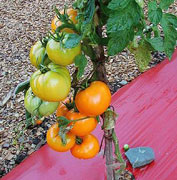


Home
Flowers &
Indoor Plants
Fruits & Nuts
Ornamentals
Vegetables
Special Topics
Resources
Glossary

Tomato |
 |
What about it? Tomatoes are the most popular garden plant. Because of their popularity, there are hundreds of tomato varieties. Tomatoes are members of the Nightshade family along with potatoes and eggplants. What is it used for? There are many different varieties for different uses of tomatoes. There are slicing tomatoes, paste tomatoes, cherry tomatoes; they also are available in a range of colors, from yellow to red to orange. Where does it grow? How do we grow it? Tomatoes need full sun and plenty of water. Some types will need trellises for support. What are its primary problems? Tomatoes are susceptible to early blight, Septoria leaf spot, blossom end rot, Fusarium wilt, and Verticillium wilt Select varieties resistant to Fusarium and Verticillium wilt Common pests are aphids, whiteflies, tomato hornworms, and tomato fruitworms. Catfacing and blossom end rot are two common disorders of tomatos; these are neither insect nor disease - related, but are caused in part by environmental conditions, and are worse in some varieties. How do we propagate it? Start tomato plants indoors 6 or 7 weeks before the last frost date. Sow seeds 12 inch apart and 1/4 inch deep. Don't set your transplants out until all threats of a frost have passed and the soil has warmed up a bit. Tomato plants should be hardened before put in the soil outdoors. Take a week to gradually introduce the plant to its new environment by setting it outdoors in the shade for a few hours each day, getting longer as the week goes by. How do we harvest and store it? Pick tomatoes when they are fully colored and firm. Do not refrigerate; store in the shade or other cool place.
© Copyright, Department of Horticulture, Cornell University. |


